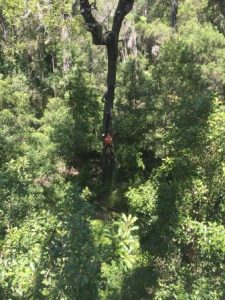
Trees are living things and all arboricultural management practices should accord with basic biological principles. For example, any pruning activity should minimise the area of an open wound and capitalise upon the tree’s natural mechanisms of growing over and sealing off.
Trees are sophisticated organisms. Their large structures and longevity indicate a complex biology, efficient integrative systems and effective biological defence mechanisms. These defence mechanisms against pests and diseases are the strongest and most effective available. Arboricultural practices must never undermine, but rather complement them.
“Stressed and aged trees have a reduced capacity for defence and so are prone to attack by pests and diseases. Their management often requires greater care than for young healthy vigorous trees.”
Prevention is better than cure is the adoption of the medical model, which suggests that preventing structural deformity, disease or decay is a superior management approach than trying to remedy problems once they arise.
A non- or minimal-interventionist approach should be followed, which suggests that intervention in the natural growth of the tree should only occur through necessity, and under conditions where the biology and the physiology of the organism are understood to such a level that intervention will have clear and predictably beneficial outcomes.
All interventions must be done in such a way as to minimize the spread of pests and disease. This necessitates the adoption of basic hygiene when dealing with trees that have been attacked by pests or diseases.
Proper urban tree management is based on a sound understanding of tree biology that informs arboricultural practice (Moore 2004). There are basic principles of tree biology that are the foundations of modern arboricultural practice, and these are of greater significance when the trees concerned are either stressed or aged.
These principles must be considered when putting tree injection processes in context. Under these principles tree injection must be seen as an invasive process that inevitably wounds the specimen involved. Accordingly, the injections should only be used when other techniques have failed and should be seen as a measure of last resort for pest control or the improvement of tree health.
With old or stressed trees there is a real risk that tree injection may actually make things worse for the specimen that you are hoping to treat, which is contrary to the principles of modern arboriculture. Consequently, tree injections must be seen as a part of a comprehensive pest control or tree management program. It should only be used when other measures have failed and when the benefits of injection can be shown to outweigh the risks to tree structure, vigour and health.
Reference
- Moore G. M., 2004. Managing Aging Trees: Implications for Tree Health. in Smith K (Ed)
- Smith K.D., 2004. Amenity Tree Health: Pests & Diseases Workshop : Workshop Proceedings. Friends of the Elms, Burnley Campus, 2004
- Friends of the Elms pamphlet, Melbourne
